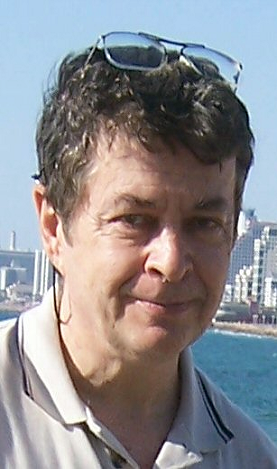|
|
Prof. Yuval Bistritz
School of Electrical Engineering The Iby and
Aladar Fleischman Faculty of Engineering |
Yuval Bistritz received
the B.Sc. in physics and the M.Sc. and Ph.D in
electrical engineering (Summa Cum Laude), in 1973, 1978, and 1983,
respectively, from
What is the Bistritz (stability) criterion?
A name attached (by other researchers of course) to a simple algebraic
method to determine the zero location with respect to the unit-circle of a real
(or complex) polynomial that I devised in [1984,1986]. It follows
a different form from the common classical forms of the Schur-Cohn
Marden-Jury stability tests that makes it reminiscent
of the Routh test (the well known algorithm to test
stability of continuous-time systems and analog filters devised by Routh in 1877). It
is the most efficient possible algebraic way to test stability of discrete-time
systems and digital filters. I presented in [2002]
a more polished version of the test that behaves the same for stability testing
but handles the zero location problem with extra simplicity.
What are the immittance algorithms?
Immittance is a prefix chosen for algorithms that follow the new
formulation that stems from my stability test in order to distinguish them from
corresponding so called scattering algorithms that follow the classical formulation (used
since Levinson, Schur, Cohn, Marden
and Jury). The term immittance was coined by Bode and is an abridged concatenation
of impedance
and admittance.
I encountered W. H. Bode's book Network Analysis and Feedback Amplifier
Design (1945) on Tom Kailath's shelf at Stanford
just when I needed a meaningful name for the new formulation. From a
mathematical perspective, the algorithms in the new formulation start with a
pair of polynomials whose ratio forms a unit-circle immittance function (a
function that is lossless on the unit-circle instead of on the imaginary axis).
What are the ISP / ISF parameters?
Immittance
spectral pairs (ISP)
or Immittance spectral frequencies (ISF) are stability parameters
proposed to code speech by the LPC model [1993].
They are part of many speech
compression standards: Third Generation
Partnership Project (3GPP) for GSM; Third generation mobile
communication WCDMA system; The ITU G.722.2 standard for wideband
speech coding; The cdma2000® Variable-Rate Multimode Wideband (VMR-WB) and
more.
My research interest includes:
- Computer algebra and symbolic computation approach to signal processing algorithms.
- Methods for testing stability of one- and multi-dimensional continuous and discrete systems.
- Topics in speech signal processing (speaker recognition, low bit-rate speech coders and more).
The information for students taking my courses has been moved to our Virtual TAU.
Return to:
[Faculty of Engineering ]
Last modified: June
2015.
